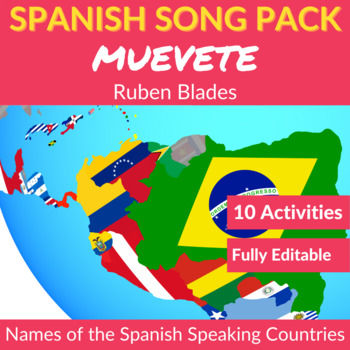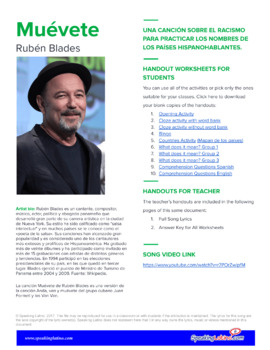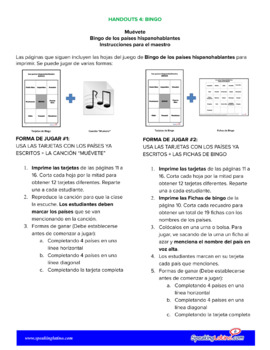
Using a song to practice the names of Spanish-speaking countries can be an effective way to learn and memorize them. Songs are often enjoyable and engaging, so they can help make learning more enjoyable and help the material stick in your mind. Additionally, the repetition of hearing the words in the context of a song can aid in vocabulary development and fluency.
“Muévete” is a song by Ruben Blades, released as the first single from his 1990 album Escenas, is a fantastic way for your students to practice the names of the Spanish-speaking countries. The song speaks of the need to push oneself and not rest on one’s laurels, to work hard and make things happen. With lyrics that urge the listener to “move yourself,” “Muevete” has become an anthem of sorts, inspiring those who hear it to take action in order to realize their dreams. The song features Blades’ signature blend of Latin music with elements of hip-hop and funk, providing a contemporary backdrop for its timeless message.
Singer: Rubén Blades
Country: Panama
Topics: Names of the Spanish-speaking countries
 Activity booklet includes:
Activity booklet includes:
• Full song lyrics: “Muévete”
• Exploratory activity: Spanish-speaking countries
• Cloze activity: Spanish-speaking countries and vocabulary
• Spanish-speaking Countries Bingo Game: Instructions and printables to play a bingo game to practice the Spanish-speaking country names. Variations include using the song and students creating their own bingo cards.
• Spanish-speaking Country Maps: Students will learn where the Spanish-speaking countries are located with two maps (the Americas and Europe/Africa) and an activity.
• Group Song Translation Exercise: Many teachers like when their students realize how many Spanish words they know when they read a short text. In this exercise, students get together in groups to translate a section of the song. The translation doesn’t need to be perfect. They start with the words they know and then look for the rest in the dictionary until they get the idea of each stanza.
• Comprehension Questions: Two versions included in Spanish and English. Students can write the answers to each question, or the teacher can use them to discuss the song in class.
Canción: Muévete
Intérprete: Rubén Blades
País: Panamá
Tema: Los nombres de los países hispanohablantes
 El folleto de actividades incluye:
El folleto de actividades incluye:
• Hoja de la letra de la canción: “Muévete”
• Actividad exploratoria: Los países hispanohablantes
• Actividad de rellenar los blancos de la canción: Los países hispano hablantes y vocabulario
• Juego de Bingo: Instrucciones y hojas listas para imprimir para jugar bingo y practicar los nombres de los países hispanohablantes. Variaciones del mismo juego incluyen el uso de la canción y la creación de tarjetas de juego por los propios estudiantes.
• Ejercicio grupal de traducción: A muchos maestros les gusta cuando sus estudiantes se dan cuenta cuántas palabras conocen en español. En este ejercicio, los estudiantes se dividen en grupos para traducir una parte de la canción. La traducción no tiene que ser perfecta. Comienzan con las palabras que pueden reconocer y luego buscan el resto en el diccionario hasta que logren entender lo que dice la estrofa.
• Preguntas de comprensión: Se incluyen dos versiones en español e inglés. Los estudiantes pueden escribir las respuestas de las preguntas o el maestro puede usar las preguntas para discutir la canción en clase.